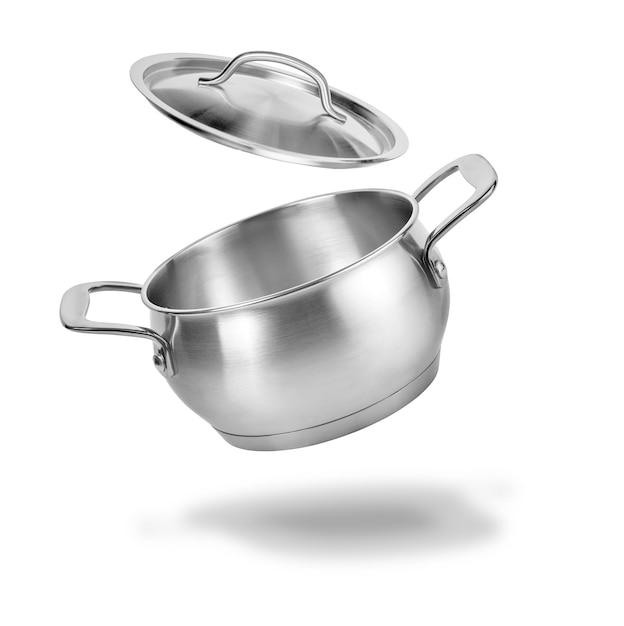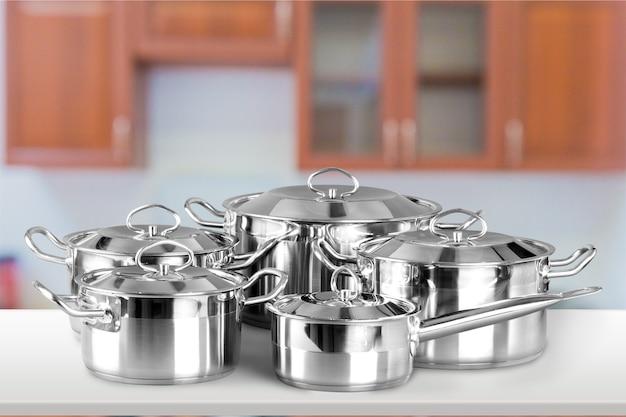Have you ever found yourself standing in your kitchen, wondering whether that pan is made of stainless steel or aluminum? The truth is, it can be challenging to tell the difference just by looking at it. But fear not! In this blog post, we’ll give you some handy tips and tricks to help you determine whether a pan is stainless steel or aluminum.
From the age-old method of using a magnet to the various health considerations associated with each material, we’ll cover it all. So, if you’ve ever asked yourself questions like “Will a magnet stick to aluminum?” or “Which is healthier, stainless steel or aluminum?”, you’re in the right place.
Join us as we navigate the world of pans, magnets, and metal materials, providing you with everything you need to know to identify if a pan is made of stainless steel or aluminum. Let’s dive right in!
How to Distinguish Between Stainless Steel and Aluminum Pans
Spotting the Difference
When it comes to cookware, it’s essential to know what you’re working with. Is that shiny pan in your hand made of stainless steel or aluminum? Fear not, dear reader, for I shall unravel this culinary mystery for you. With a few simple tricks up your sleeve, you’ll become a pan detective in no time.
The Magnet Test
Ah, the trusty magnet, our loyal assistant in the realm of metallic detection. A quick and easy way to determine if your pan is stainless steel or aluminum is to grab a magnet and give it a whirl. If the magnet clings to the pan, congratulations, you’ve got yourself a stainless steel beauty. If, on the other hand, the magnet keeps its distance as if it’s seen a ghost, then it’s an aluminum imposter. Case solved with the help of a magnetic ally!
Observing the Weight
Now, let’s add a touch of Sherlock Holmes to our investigation. Pick up the suspect pan and feel its weight. Does it feel substantially light, like a feather on the wind? Then, my dear reader, it’s likely made of aluminum. On the other hand, if it feels more robust, with a heft that whispers of durability and strength, it just might be stainless steel. Remember, weight can be a valuable clue when it comes to your pan’s true identity.
Analyzing the Surface
Prepare your detective magnifying glass and direct your keen gaze onto the surface of the pan. Stainless steel and aluminum have distinct visual characteristics that can aid in their identification. Stainless steel pans are known for their smooth and shiny appearance, like a polished mirror. On the contrary, aluminum pans tend to have a more matte finish, lacking that dazzling sheen. Keep your eyes peeled for these subtle telltale signs as you scrutinize your cookware collection.
Conducting the Temperature Test
As a true aficionado of culinary investigations, you must never shy away from a challenge. To put your pan-detecting skills to the ultimate test, let’s talk about temperatures. Heat your pan, whether it’s over the stovetop or in the oven, and pay close attention. If your pan heats up quickly and evenly, rejoicing in the warmth like a contented pup, that’s unmistakably aluminum. But if it takes a bit longer to warm up, like a patient tortoise in a race, it’s most likely stainless steel. Ah, the nuances of temperature can reveal so much!
Seeking Assistance from a Sharp Friend
If all else fails and you’re still uncertain about your pan’s true material, it’s time to bring out the big guns. No, not your secret weapon or your great aunt’s legendary spatula, but a friend we all love and cherish – a knife! Give the pan’s surface a gentle scrape with a knife. If the metal leaves a mark or a clear scratch, bravo! That’s aluminum showing its vulnerability. However, if the pan remains unscathed, shrugging off the assault like a noble knight, it’s stainless steel, my dear compatriot in cooking adventures.
With these tools in your culinary arsenal, you can confidently tackle any pan-related mystery. No more second-guessing or kitchen mishaps! So go forth, proud pan detectives, and conquer the world of cookware with your newfound wisdom.
Happy cooking, my dear friends, and may your pots and pans always be true to their stainless steel or aluminum nature!
FAQ: How Can You Tell If a Pan Is Stainless Steel or Aluminum
In the world of cookware, it’s important to know what you’re working with. Whether you’re a professional chef or simply whipping up a meal at home, understanding the material of your pans can make a big difference in your cooking experience. So, let’s dive into the frequently asked questions about distinguishing between stainless steel and aluminum pans!
Will a Magnet Stick to Aluminum
Contrary to popular belief, aluminum is not magnetic. So, if you grab that fridge magnet and it won’t stick to your pan, chances are it’s made of aluminum.
Which Is Healthier: Stainless Steel or Aluminum
In terms of health, stainless steel takes the cake! Aluminum pans may leach a small amount of metal into your food, especially when cooking acidic or salty dishes. On the other hand, stainless steel is non-reactive and won’t transfer any harmful substances, making it the healthier choice.
Will a Magnet Stick to 304 Stainless Steel
Yes, it will! One of the great qualities of 304 stainless steel is that it is magnetic. So, if you’re testing your pan with a magnet and it sticks, chances are it’s made of 304 stainless steel.
Which Is Better: Stainless Steel or Aluminum Cookware
Well, it depends on what you’re looking for. Stainless steel pans are durable, resistant to corrosion, and distribute heat evenly. Aluminum pans, on the other hand, heat up quickly and are lightweight. So, if you prioritize longevity and versatility, stainless steel is the way to go. If you prefer a lightweight option with excellent heat conductivity, aluminum might be your best bet.
Is Cooking in Aluminum Bad for You
Using aluminum pans isn’t necessarily bad for your health. However, it’s best to avoid cooking highly acidic or salty foods in them, as they can increase the chances of metal leaching. If you stick with stainless steel or cookware with a non-reactive coating, you can enjoy your meals without worries.
How Can I Tell If Something Is Aluminum
Well, here’s a fun trick! Aluminum is a great conductor of heat, so just touch the pan with your hand. If it quickly heats up, you’re most likely dealing with an aluminum pan. Just make sure it’s not scorching hot before performing this experiment!
Can I Shower with Stainless Steel
While stainless steel pans are excellent at cooking your favorite dishes, they’re not besties with water and soap. So, leave the stainless steel cooking in the kitchen and stick to your regular shower routine.
Is Cooking in Aluminum Pots Bad for You
Similar to aluminum pans, cooking in aluminum pots is generally safe. However, it’s a good idea to avoid acidic or salty recipes to minimize the risks of metal leaching. If you’re whipping up a mouthwatering tomato sauce, it might be best to use a different pot.
Is It Better to Cook with Stainless Steel or Nonstick
Ah, the great cookware debate! Stainless steel offers durability, even heat distribution, and versatility, but food tends to stick if not properly used. Nonstick pans, on the other hand, are a breeze to clean and ensure your culinary creations effortlessly glide around the pan. Ultimately, it boils down to personal preference and the type of cooking experience you desire.
Why Do Stainless Steel Pans Have Aluminum
Well, it’s like a beautiful friendship! Stainless steel may be a fantastic material for cookware, but it’s not the best at conducting heat. By adding an aluminum core to the base of stainless steel pans, heat distribution becomes more efficient, giving you the best of both worlds.
Does Aluminum Leach Through Stainless Steel
Fear not, my friend! When you have stainless steel cookware, you can rest easy knowing that the stainless steel acts as a protective barrier. So, no need to worry about any aluminum leaching into your delicious meals.
Can Stainless Steel Rust
Not if it’s high-quality stainless steel! The invisible superhero behind stainless steel is chromium. It forms a thin protective layer called chromium oxide, which prevents rust from making an unwanted appearance. So, to all the stainless steel pans out there, keep on shining!
What Cookware Does Not Contain Aluminum
If you’re aiming to avoid aluminum cookware, there are plenty of options available. Look for cookware made from materials such as cast iron, copper, stainless steel, or ceramic. These alternatives offer a wide range of benefits and are aluminum-free.
How Long Will Stainless Steel Last
Ah, the eternal question! With proper care and maintenance, your stainless steel pans can last for years and years. They’re tough, resistant to corrosion, and designed to withstand the heat of your kitchen adventures. So, give them some love, and they’ll be your loyal culinary companions for a long time to come.
Is Stainless Steel Allergy-Free
Yes, indeed! Stainless steel is hypoallergenic and doesn’t typically cause any allergic reactions. So, you can confidently cook up a storm without worrying about unwanted skin irritations.
What Grade of Stainless Steel Will Not Rust
When it comes to stainless steel, the grade matters. Look for pans made of 304 or 316 stainless steel. These grades contain a high amount of chromium, ensuring a sturdy shield against rust. So, rust be gone!
Is There Aluminum in Stainless Steel Pans
Pure stainless steel doesn’t contain aluminum. However, some stainless steel pans have an aluminum core or aluminum layers to enhance heat distribution. Rest assured, though, as long as the aluminum is well protected and sealed within the stainless steel, you won’t have any direct contact with it during cooking.
How Do You Tell If Something Is Stainless Steel
If you’re unsure whether you’re dealing with stainless steel, you can conduct a simple test. Obtain a magnet, give it a little wave, and see if it sticks to the pan. If it does, congratulations, you’ve got stainless steel in your hands!
Will a Magnet Stick to Stainless Steel
Indeed, it will! Most stainless steel alloys have some degree of magnetism, allowing the trusty magnet to cling on tightly. So, if your magnet is feeling a magnetic attraction, you’ve got yourself a stainless steel pan.
What Is the Difference Between Steel and Aluminum
Ah, steel and aluminum, both shining stars in the world of metals! The main difference lies in their composition. Steel is primarily made from iron mixed with carbon, while aluminum is a lightweight metal on its own. Steel is sturdy, strong, and excellent for durability, whereas aluminum shines in terms of its exceptional heat conductivity and lightweight nature.
Will a Magnet Stick to 409 Stainless Steel
No, sorry mate! 409 stainless steel is not magnetic, so your magnet will give it the cold shoulder. If the magnet walks away without sticking, you’re definitely working with 409 stainless steel.
Now that you’re armed with all the knowledge about distinguishing between stainless steel and aluminum pans, it’s time to get cooking with confidence. Choose the right material for your culinary adventures, and enjoy the delightful magic that happens in your kitchen!

